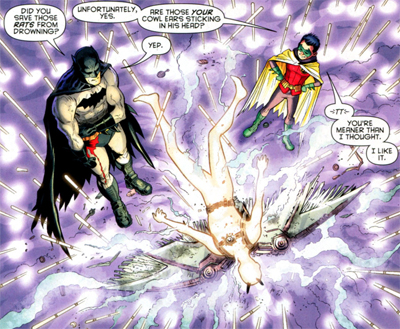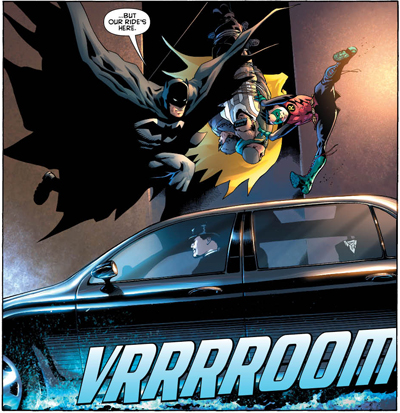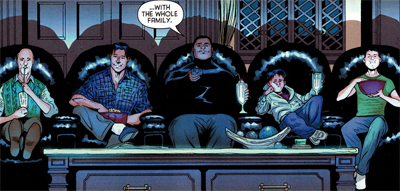To celebrate the release of The Dark Knight Rises, July is “Batman month” here at the m0vie blog. Check back daily for comics, movies and television reviews and discussion of the Caped Crusader.
Today we’re taking a look at three of the authors who followed Grant Morrison’s groundbreaking Batman & Robin run. And, in the middle, are Peter Tomasi and Patrick Gleason.
It seems that Peter Tomasi and Patrick Gleason were originally intended to be the full-time creative team succeeding Grant Morrison on Batman & Robin, allegedly chosen by the Scotsman himself to take over the title. However, possibly due to the post-Flashpoint reboot, the series ended up bouncing around various authors and artists, including Judd Winick and Paul Cornell. However, Tomasi and Gleason did manage to contribute one three-issue storyline to the title before the relaunch, Tree of Blood. While it might not be the most conceptually fascinating Batman story, it does show that the team are well suited to the title, and serves as an appetizer for their current run.
There are, to be frank, quite a few problems with Tree of Blood. Paul Cornell’s The Sum of Her Parts might have been (somewhat) flawed, but it certainly had ambition. It felt like a more modest spiritual successor to Morrison’s run, daring to pick apart the conventions of a standard Batman story and to contextualise decades of publishing history within the narrative itself. Dealing with the gender issues of a Batman comic inside a Batman comic might not be the easiest thing to do, but it shows a great deal of creative daring. In contrast, Tomasi’s Tree of Blood seems like it’s treading water, telling a fairly conventional story with a fairly conventional premise.
In fact, the bad guy of the piece is quite a disappointing character, and an example of the workman-like plotting. While Tomasi gives the character an interesting hook in contrast to Batman (“the White Knight” as against “the Dark Knight”) and Gleason gives him a nice appearance (literally glowing), the character features the blandest and most predictable of back stories. Somebody hurt his family, and he is responding in kind – seeking to kill the families of Gotham’s most notorious of villains. It’s not that there’s anything inherently flawed with the premise, but the execution is mundane.
Compare the White Knight to any of Morrison’s brief villains and he comes up quite short. Despite receiving more in-depth coverage and more nuance and motivation, the character can’t measure up to the Flamingo (“the Eater of Faces”), Professor Pyg, or even the deranged Batman clone. The ingredients are there, but there’s just something wrong with the way that Tomasi handles him, providing us with a last-minute motive rant and flashback that erodes away some of the more fascinating visuals by giving us a paint-by-numbers villain origin. It’s a shame, because there are some lovely bizarre images, including the strange angel fetish and the tree that the villain tends to.
In a way, Tree of Blood is more interesting if one ignores the fairly conventional plot, and instead focuses on the smaller moments and interactions, the lighter touches and the way that Gleason handles the working cogs inside a world defined by another author. As Tomasi and Gleason both demonstrated working on Green Lantern Corps, they excel at developing a world created by another author, adding the details that give the wider series a bit of texture. I hope that pair can do the same for Morrison’s Batman that they did for Geoff Johns’ Green Lantern.
The character moments really shine, to the point where the plot itself seems like an excuse to string a bunch of them together. Not the least of which is the opening sequence, where Bruce sits down to share The Mask of Zorro with “the whole family.” Let’s ignore, in light of the last story in this series, the unfortunate implications that none of the women in the extended Batman family gets invited along, and it’s a sweet moment. However, it seems to have little to do with the rest of the plot, save providing Bruce with a cameo and firmly establishing this as the post-Morrison era, where Bruce is no longer an anti-social loner who drives away those close to him.
That said, Tomasi casts Alfred in the role of the Bat-family’s father figure, which is a nice touch. It’s easy to forget how young Dick Grayson is, while wearing that iconic cowl, and the wealth of experience he has to draw on from the Wayne household. Whether it’s remembering his shoes or tying his bow tie, Alfred feels like even more of a father-figure than usual. I especially like the way he tries to place Das Rhinegold within Dick’s cultural frame of reference. “Did you enjoy Bugs Bunny in “What’s Opera Doc?” as a boy?” Alfred is very much the father-figure to the franchise, having guided Bruce from early childhood, yet remaining quietly and loyally in the shadows. Tomasi handles him well.
Similarly, even Commissioner Gordon gets some nice moments, despite being frequently forgotten as part of the mythos. He’s presented as the stoic figure who deals with the consequences of the events that Batman floats in and out of, another constant in an ever-changing world. He’s solemn and respectful, as we see in the way that he treats the deceased. It’s a nice touch, and one which hints at the humanity in the character. Gordon is, after all, the most normal and the most human of the Batman supporting cast, the ordinary cop living in a world of psychotic clowns and men dressed like flying rodents. There’s something tragic and touching about that, and Tomasi manages to subtly evoke it.
However, the real star of the show is Damian. Batman & Robin is, after all, the book that features the ten-year-old the most in the entire Batman line, and his presence pretty much sets the mood that Morrison established – the pint-sized master assassin just as dark and camp and ridiculous as the franchise at its extremes. Tomasi seems to point to Damian as the central figure in this particular story, and Tree of Blood is very much about Damian, in much the same way that The Sum of Her Parts was actually about Bruce, even though it barely featured him.
Tomasi somewhat clumsily points out the connecting material, but the story of a villain hoping to stop the “next generation” was always going to tie in thematically to Damian. After all, any plot focusing on bloodlines will inevitably confront the issue of “nature vs. nurture”, and Morrison has set up a pretty compelling internal conflict in the little brat. He’s the son of Batman, but also the son of one of Bruce’s greatest enemies. With those two halves at war within Damian, which will win? Is he predestined one way or the other?
When Damian observes that their villain clearly believes that the apple doesn’t fall far from the tree, Dick responds, “Sometimes it does, sometimes it doesn’t.” Damian immediately retorts, “That a shot at me?” It couldn’t help but be, even if Tomasi never really pushes the issue quite to the fore, drawing attention to it, but never really following through. In another awesome moment for everybody’s favourite butler, Alfred tells Damian, “In the end, you make you. No one else.” I suspect that this internal conflict will end up playing a major role in Tomasi’s run.
With regard to the character of Damian himself, Tomasi has a very solid grip. The character can be very tough to write, due to his somewhat surreal nature. While Morrison exaggerated all the characteristics of his little terror, Tomasi seems to want to bring a slightly more psychologically realistic approach to Damian. Morrison’s writing brilliantly played to the extremes of the spoilt ten-year-old brat and the cynical master assassin, while Tomasi seems to be hoping to reconcile both aspects. I particularly like the suggestion that Damian has an especially strong dislike of those who victimise children. “And this guy used the stuff on kids?” he asks, rhetorically. “I’m going to enjoy smashing this White Knight’s face when we find him.”
Tomasi and Gleason both come very close to evoking the style of Morrison’s brilliant run, if never matching its substance. These three issues probably look most like Morrison’s sixteen-issue run, and that’s due to a wonderful working synergy between the pair. I especially like how Tomasi coopted smaller aspects like Damian’s “tt”, while Gleason evokes the sort of cartoony art that Cameron Stewart and Frank Quitely brought to the title. Tomasi even uses Man-Bat, in a call back to Morrison’s first Batman arc.
In particular, the pair borrow Morrison’s consciously neon motif, with the interplay of light and darkness giving the story a beautiful visual look. There’s something surreal and unnerving about seeing Arkham Asylum “lit up like a Christmas Tree”, looking just as creepy as Pyg’s fairground, with its bright colours masking some fairly sinister content. Gleason is a wonderful artist when it comes to capturing figures in motion, and I look forward to seeing his artwork here. I would have been hard to imagine Gleason’s exaggerated and cartoonish style fitting a Batman book so well, but it actually gives a wonderful Morrison-ian vibe to the adventure.
Tree of Blood isn’t exceptional. In fact, it feels almost like a holding pattern, treading water with a pedestrian plot, while giving us a taste of some of the character work that Tomasi has in store. It isn’t overly impressive of itself, but it does have a number of elements that bode well for Tomasi and Gleason’s stint on the on-going Batman & Robin title after the relaunch.
You might be interested in our reviews of other writers’ work on the first volume of Batman & Robin:
- Grant Morrison’s run
- Paul Cornell’s run
- Peter Tomasi’s run
- Judd Winick’s run
Filed under: Comics | Tagged: arts, batman, batman & robin, batman robin: tree of blood, damian wayne, dark knight, Dark Knight Rises, Das Rheingold, Gleason, grant morrison, Grantmorrison, patrick gleason, Paul Cornell, peter tomasi, robin, Tomasi, tree of blood, white night |



























Leave a comment